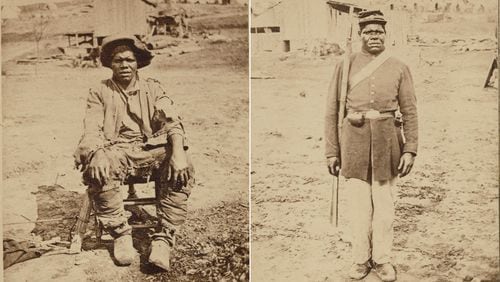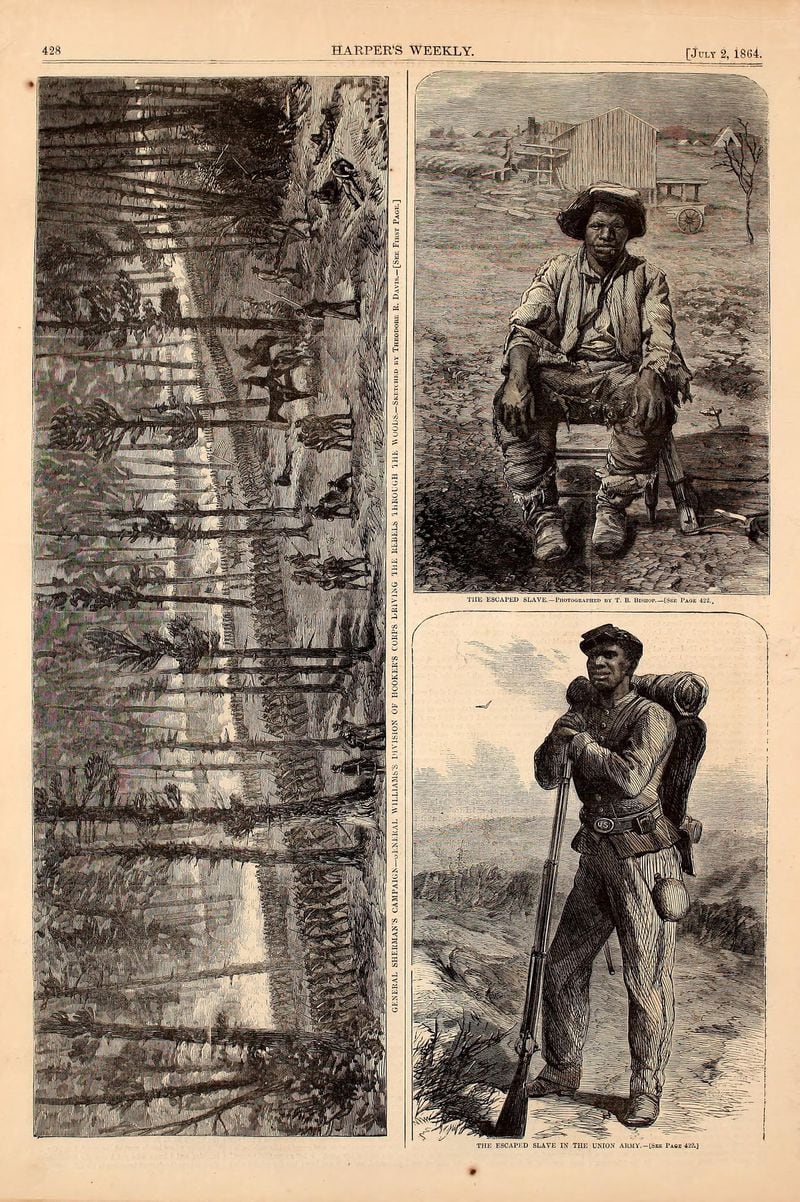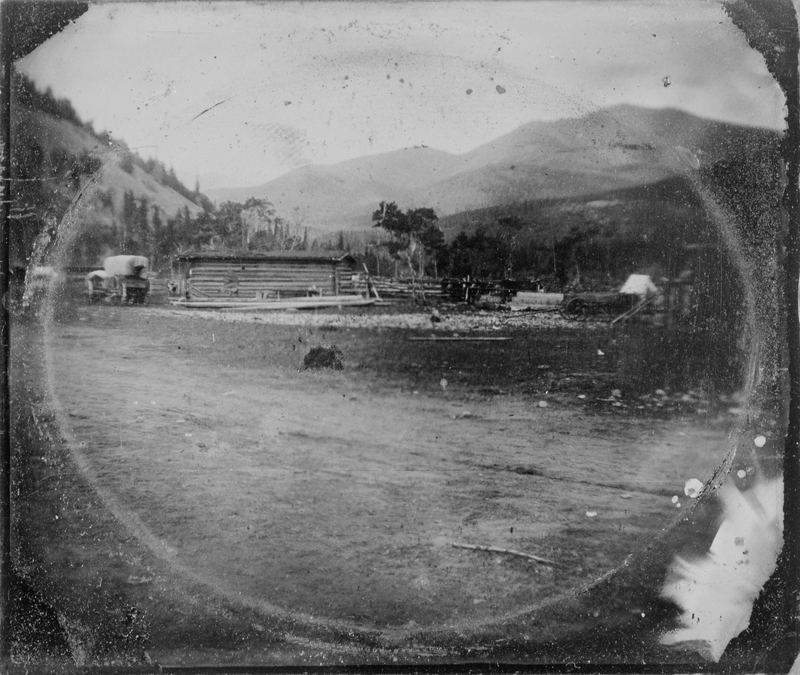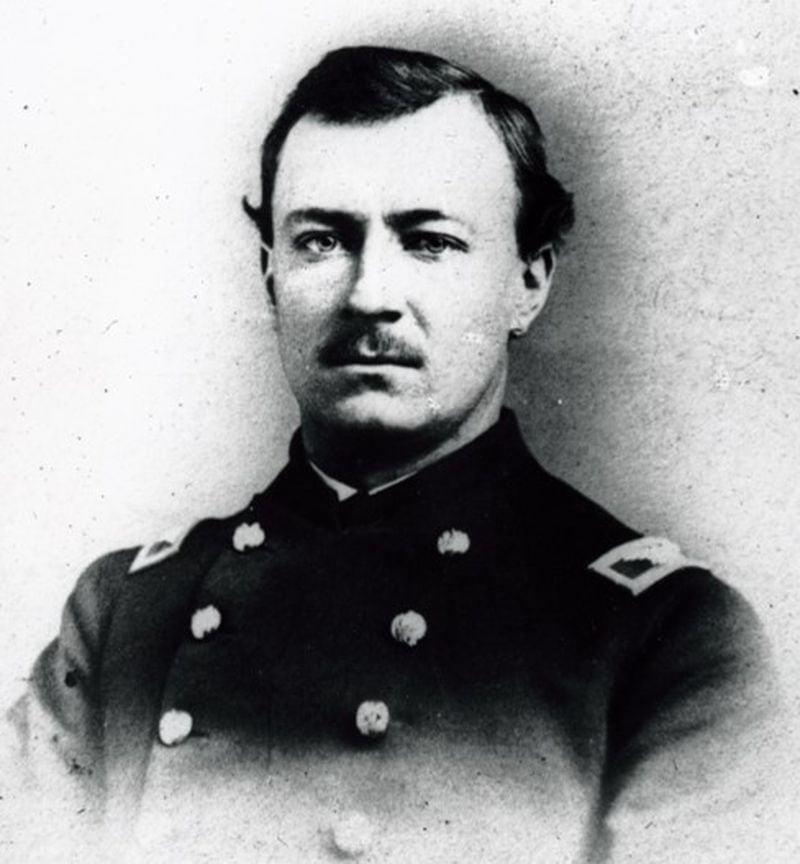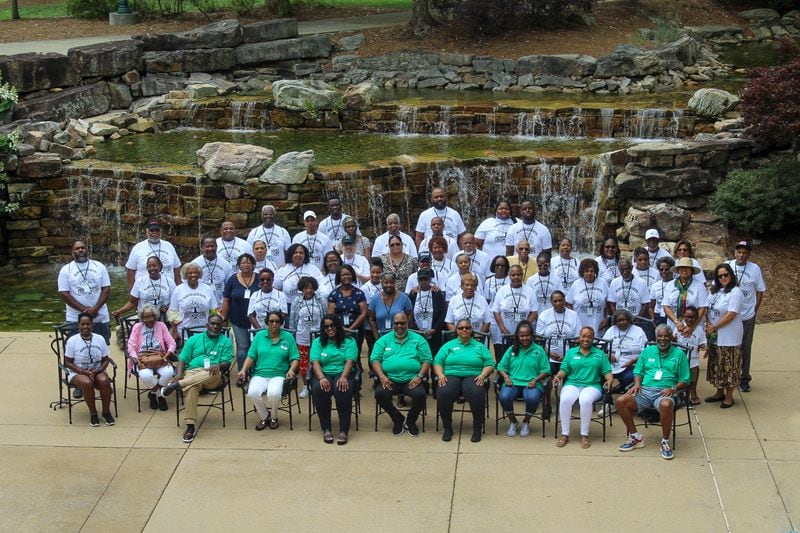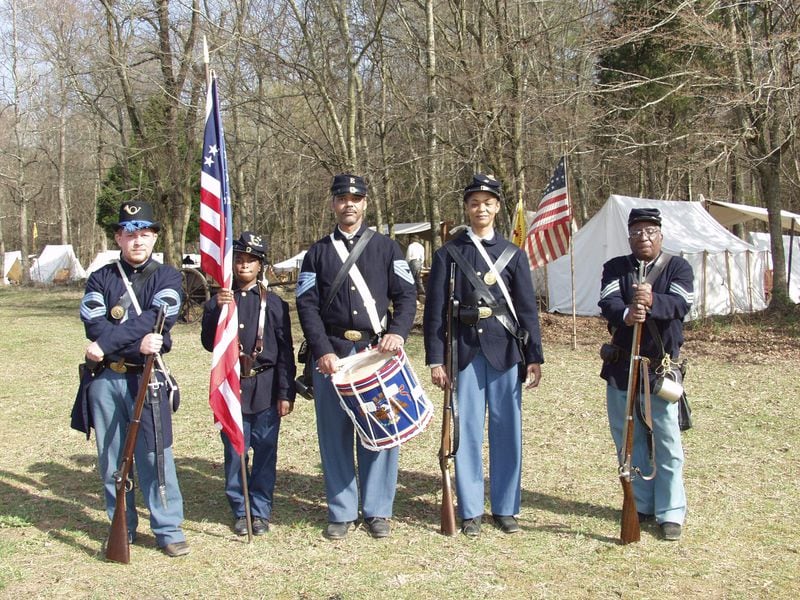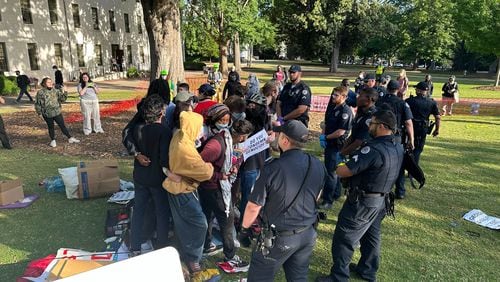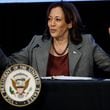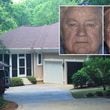DALTON — Through their sharp contrast, the photos of Hubbard Pryor tell a remarkable story about resilience.
In the first, he is seated, dressed in possibly the same tattered clothes he wore during his escape from enslavement in North Georgia. In the second, he is standing at attention, smartly dressed in a Union Army uniform and shouldering a rifle.
Shot in the spring of 1864, the pictures reveal a man who risked everything to fight for the freedom of others still in bondage.
Pryor’s impassive expressions in both photos do not betray his feelings, though he must have been relieved to have survived his escape. He also could have been filled with pride wearing his blue uniform. Many Black men fought in the same uniform with distinction. By the end of the war, 26 African Americans earned the Medal of Honor for valor.
When he posed for his photos, Pryor might also have been dreading what was ahead. Nearly a quarter of the roughly 200,000 Black men who served in the federal military during the Civil War died, including about 10,000 in battle and 30,000 from diseases and infections. Some were massacred by Confederates after they were overwhelmed and sought to surrender.
Pryor’s images also help tell a different story, a harrowing tale about those who escaped enslavement and briefly tasted freedom before losing it once more. Pryor had already survived captivity once. Could he do it again?
The escape
Historians have connected Pryor to Haden Prior, an affluent landowner who had 117 slaves in Polk County near Cedartown. Hubbard’s last name is variously spelled as “Pryor” and “Prior” in his military records.
It’s unknown precisely how and when Pryor escaped and arrived at the Union enlistment office in Chattanooga in the spring of 1864. The year before, President Abraham Lincoln had issued his Emancipation Proclamation, which was largely ignored by Southern states. Slave patrols roamed the region, seeking escapees.
But federal forces captured Chattanooga, and it became a major hub for the recruitment of Black troops. Pryor enlisted there in the 44th Colored Infantry Regiment, according to his military records, which identify him as a 22-year-old farmer who stood 5 feet, 7 inches.
His photos were taken in Tennessee by Algenon Morse, a prolific Civil War photographer who traveled with the Union army. Harper’s Weekly published a woodcut engraving of one of them, just four months after Pryor enlisted. Though it does not name Pryor, an article in the same edition calls him a “poor fugitive, who, from the heart of the enemy’s country, gives himself, at the risk of death or of a torture worse than death, to a cause simply because it is inevitably associated with the problem of his freedom.”
Credit: Harper's Weekly via Internet Archive
Credit: Harper's Weekly via Internet Archive
Copies of Pryor’s pictures were likely shared among Union army officers to promote the recruitment of Black soldiers, said Ronald Coddington, a Civil War historian who wrote about Pryor in his book, “African American Faces of the Civil War.”
“And how best to do that than by showing: Here is the condition of this man when he came in and here is how he looks in his blue uniform?” said Coddington, a former Atlanta Constitution staff artist who publishes Military Images magazine. “That sends a really powerful message — this is what you could be.”
Pryor’s photos were enclosed with a letter that Col. Reuben Mussey, an infantry commander and recruiter of Black soldiers, sent to the Bureau of Colored Troops in Washington, D.C. A former educator and newspaper journalist from New Hampshire, Mussey wrote Pryor’s unit did “considerable fatigue duty” during its formation, including gardening at a hospital.
Frustrated that such noncombat labor was repeatedly assigned to Black soldiers, Mussey was threatened with dismissal because he so often insisted they be given opportunities to fight. Some eventually got their chance.
In August of 1864, a sister unit, the 14th Colored Troops Infantry Regiment, helped defend a small garrison in Dalton that was protecting Gen. William Sherman’s supply lines during his Atlanta campaign.
Battling about 5,000 Confederate soldiers, the 14th killed five rebels and wounded others. A 14th soldier was killed in the fighting, while another lost a leg and a third was wounded in the hand.
A month later, Pryor’s 44th Regiment moved to Dalton. He and his fellow infantrymen were about to get into the fight.
Credit: Robert Davis photo of image from the Georgia Archives
Credit: Robert Davis photo of image from the Georgia Archives
Captured
Pryor’s regiment was led by Col. Lewis Johnson, a German immigrant highly regarded by his Union army superiors. Before taking command of the 44th, Johnson fought in several battles, including at Chickamauga, and was wounded twice, according to Robert Davis. The historian added that Johnson, an idealist who came from a well-educated family, respected the Black soldiers he commanded and encouraged them to learn to read and write.
Credit: Photo courtesy of Cheryl Johnson-Ludecke
Credit: Photo courtesy of Cheryl Johnson-Ludecke
A report Johnson sent Mussey describes what happened in Dalton on Oct. 13, 1864. That day, Johnson learned railroad tracks south of the city were burning and that a rebel force was approaching. Fighting ensued. Then a rebel officer approached under a flag of truce, bearing a message from Confederate Gen. John Hood.
Hood, who had been defeated by Sherman in Atlanta, demanded that Johnson immediately surrender the garrison, warning: “If the place is carried by assault, no prisoners will be taken.”
Johnson refused. Fighting resumed. Nine rebels were killed and about 20 were wounded. Soon, Hood’s vast Confederate army, numbering in the tens of thousands of men with dozens of cannons, surrounded Johnson’s regiment of about 750 men.
Johnson knew the dangers he and his men faced. Just six months earlier, Confederates massacred both Black and white Union soldiers who attempted to surrender after a battle at Fort Pillow in western Tennessee. But Johnson also recognized his garrison’s situation was hopeless. He surrendered, asking that his men be treated humanely as prisoners of war.
Johnson wrote Mussey that the 44th’s Black soldiers wanted to fight “although all could plainly see what an immense force threatened us and that there was no hope whatever. It grieved me to be compelled to surrender men who showed so much spirit and bravery.”
The Confederates robbed their Black captives of their shoes and then ordered them to tear up nearly two miles of railroad tracks. One Black soldier who refused was shot. Five others who were sick and unable to keep up were also shot and left on the road. Some were returned to their slave masters. Johnson and the other white officers were eventually released.
Surviving
Pryor was among a few hundred 44th captives who were marched to Alabama and then forced to rebuild Confederate railroads and fortifications in Mississippi, according to historians.
After the war ended in April 1865, the remaining prisoners were left 40 miles south of Atlanta near Griffin, according to an affidavit Pryor filed years later to ensure he was not listed as a deserter. On foot, Pryor made his way back to his home in North Georgia in a “sick, broken down, naked and starved condition.”
“The country everywhere was full of returned Confederate soldiers,” says Pryor’s affidavit, which was signed by two other 44th soldiers who were taken prisoner. Pryor, the document adds, “traveled after night and was fearful of being killed” by the former rebel troops.
Pryor did not know the 44th formed again while he was held captive and that it had exacted revenge by helping defeat what was left of Hood’s army in Nashville in December 1864.
Five years after the war ended, Pryor married a fellow former slave from North Georgia named Ann. They moved to Calvert, Texas, she wrote in an affidavit she filed for widow pension benefits after Pryor died in 1890. The couple had four children, including his namesake, Hubbard Pryor Jr.
Historians are struck by Pryor’s perseverance.
“The more I learned about him, the more amazed I became,” said Davis, who wrote about Pryor for Prologue magazine.
Caroline Newhall, who teaches history at Oberlin College & Conservatory and who has also written about Pryor and other Black soldiers captured during the Civil War, holds a similar view: “These men had so much courage that it’s just staggering.”
Remembering the 44th
Like Pryor, William Thomas Freeman served in the 44th and was captured in Dalton. Freeman survived captivity and helped create a community called Freemantown on what is now Berry College’s campus near Rome. He is buried there.
Every five years, Freeman’s descendants gather on the campus to honor him. Cheryl Freeman Snipes, a descendant who lives in the Detroit area, founded the Freemantown Historical Foundation.
Credit: Addison Howard/Berry College
Credit: Addison Howard/Berry College
One of Snipes’, Chattanooga area resident Donald Tatum, joins others in helping keep the 44th’s memory alive by reenacting its battles. They wear replica Union army uniforms as they march and set up campsites.
Credit: Courtesy of the 44th Colored Infantry Regiment reenactment group
Credit: Courtesy of the 44th Colored Infantry Regiment reenactment group
In 2010, officials erected an historic marker in Dalton, honoring the 44th. Among those who attended the unveiling of the marker was Cheryl Johnson-Ludecke, the great-granddaughter of Col. Lewis Johnson, the regiment’s commander.
“It was very special and memorable — one of the most special moments in my life,” said Johnson-Ludecke, a Florida resident who has written a book about her great-grandfather.
Curtis Rivers, a retired U.S. postal worker who participates in 44th reenactments with Tatum, also attended the 2010 ceremony in Dalton. He directs the Emery Center, which features an exhibit focusing on Black men who served in the Union army. The exhibit displays two framed pictures of someone Rivers calls a “trailblazer.” They are the same photos of Hubbard Pryor that were taken after he escaped from slavery and enlisted. His pictures sit next to a wall bearing a large U.S. flag, the same flag Pryor risked his life and liberty to defend.
